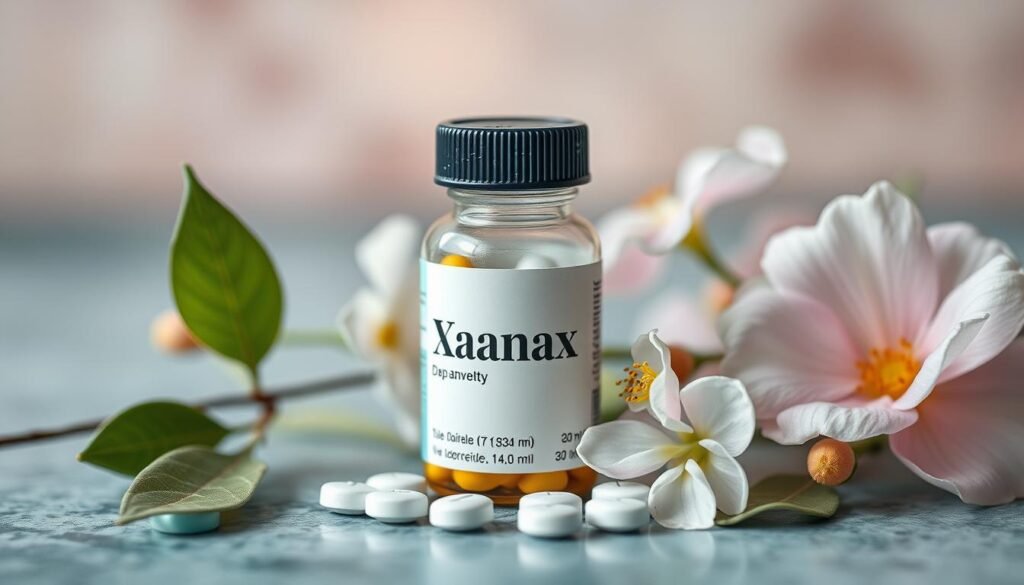Alprazolam, better known as Xanax, tops the list of prescribed psychotropic drugs in the U.S. In 2013, doctors handed out over 48 million prescriptions. This huge number shows how common anxiety and depression are. It also shows how much people rely on Xanax to deal with these issues. But, Xanax is also the second most common drug causing emergency visits due to misuse. So, it’s important to look closely at xanax for anxiety and depression reviews. This helps us see how effective and safe it is.
Xanax is famous for treating anxiety and panic disorders quickly. Many users say it’s a game-changer for them. However, some raise red flags about its addictive nature and withdrawal symptoms. The many user reviews on WebMD offer a treasure trove of insights. These reviews, both good and bad, help us grasp the effects of using Xanax for anxiety and depression. They stress the need for careful use under a doctor’s guidance.
Key Takeaways
- Alprazolam is the most prescribed psychotropic drug in the US.
- Over half of benzodiazepine prescriptions are made by primary care physicians.
- Eighty-five percent of people with depression also meet criteria for generalized anxiety disorder.
- Xanax may provide significant relief from anxiety but carries a risk of addiction.
- Understanding user reviews can aid in making informed decisions regarding its use.
Understanding Xanax: The Basics
Xanax is the brand name for alprazolam, a type of benzodiazepine medication. It’s mainly used to help adults with anxiety and panic attacks. Understanding xanax means knowing it works by calming the central nervous system. This action significantly relieves anxiety in people under extreme stress.
Xanax comes in several strengths like 0.25 mg, 0.5 mg, 1 mg, and 2 mg. It’s typically taken in doses ranging from 0.25 mg to 2 mg three times a day. For continuous relief, Xanax XR is used once a day, especially for panic disorders. The highest dose allowed is 4 mg daily for anxiety and up to 10 mg for panic attacks.
It’s important to stick to the prescribed doses since the government closely controls Xanax. This is because of the high risk of misusing benzodiazepines, including Xanax. Doctors usually don’t recommend using it for more than 4 months for anxiety or 10 weeks for panic issues.
Sometimes, doses need changes, especially for those over 65 or with liver problems. In certain cases, doctors might prescribe Xanax to children or for insomnia or pre-surgery anxiety. It’s critical to use it as instructed for each person’s specific needs.
Always keep Xanax in a safe place and follow the doctor’s instructions closely. There are tools and features to help manage your medication safely, away from others.
To understand more about treatment options for mental health, you can read about SSRIs. They’re approved for conditions like anxiety and major depression. To expand your knowledge on managing mental health, explore this guide to antidepressants.
The Role of Xanax in Treating Anxiety and Depression
Xanax, also known as alprazolam, mainly treats xanax treatment for anxiety. It helps with panic disorders. This drug boosts a natural chemical in our body named GABA. This effect makes Xanax quick in easing anxiety, often working within 15 minutes.
Although Xanax helps with anxiety, its use for xanax and depression is debatable. Some studies from the ’90s suggest using Xanax for depression. Yet, it’s controversial because of addiction risks and potential to make depression worse. Healthcare professionals are careful with prescribing it for depressive symptoms.
Xanax comes with strong FDA warnings, including serious side effects risks. These warnings highlight dangers when mixed with opioids or alcohol, which can lead to severe outcomes including death. Dependency risk increases with long-term use over 4 mg daily or therapies extending over 12 weeks.
Today, many doctors prefer newer treatments for depression over Xanax. Nonetheless, for those battling both depression and anxiety, Xanax might be a short-term option. It’s important for doctors to watch patients closely. They must assess mental health carefully to avoid risks from benzodiazepines.
Xanax for Anxiety and Depression Reviews
Xanax, or alprazolam, tops the list of prescribed psychotropic drugs in the US. Around 4% of people worldwide struggle with anxiety. So, understanding xanax user experiences is key. These insights help measure its real impact on anxiety and depression.
Real Experiences from Users
Users share varied experiences with Xanax. Many find quick relief from anxiety, pointing out its speed during panic attacks. They mention:
- It works fast, in about one to two hours.
- It greatly improves sleep for those with anxiety-induced insomnia.
- Users find it easy to use and highly effective.
However, not all feedback is wholly positive. Some appreciate its benefits but worry about dependency and side effects. The variety of xanax reviews shows both the good and the cautionary tales. It’s a mix of grateful messages and concerns over long-term use.
Comparative Analysis of Effectiveness
Compared to other treatments, Xanax might excel, especially short-term. Research and user stories support its effectiveness. Highlights include:
- Users prefer it, noting its clear advantage over placebos.
- Studies show it beats some antidepressants in immediate relief.
This comparison indicates a need for closer scrutiny, especially with potential bias in research. A candid look at xanax effectiveness for anxiety and depression matters. It guides finding the right treatment.

Effective Use of Xanax: Dosage and Administration
Using Xanax correctly means knowing the right dose for anxiety and depression. This medicine is mainly for anxiety. You must talk to a doctor to get a safe and effective plan.
Recommended Dosages for Anxiety and Depression
For treating anxiety, start with 0.25 to 0.5 mg of Xanax three times a day. Don’t go over 4 mg in one day. For panic issues, begin with 0.5 mg three times daily. You can up this to 10 mg throughout the day. Be careful when changing doses, especially with other meds, age, and liver health in mind.
Timing of Doses for Optimal Results
Xanax works fast, in about 5 to 10 minutes, peaking in effectiveness in 1 to 2 hours. Spread out doses during the day for steady anxiety control. Usually, taking Xanax 2 to 3 times daily works well, as your doctor advises. Knowing its 11-hour half-life helps avoid anxiety spikes.
| Condition | Starting Dosage | Maximum Dosage | Frequency |
|---|---|---|---|
| Generalized Anxiety Disorder | 0.25 – 0.5 mg | 4 mg per day | Three times daily |
| Panic Disorder | 0.5 mg | 10 mg per day | Three times daily |

Benefits of Xanax for Anxiety and Depression
Xanax is effective for anxiety and depression. It quickly helps with acute anxiety attacks. It also improves sleep for those disrupted by anxiety. Many have shared how Xanax positively changed their lives.
Relief from Acute Anxiety Attacks
Xanax works fast to reduce acute anxiety. People often feel better within an hour of taking it. This makes it a trusted option for sudden anxiety. Users say Xanax eases physical and emotional symptoms, giving peace of mind in stress.
Improvement of Sleep Quality
Those with anxiety often have sleep problems. Xanax helps by calming the mind for better sleep. Users say it not only extends sleep but improves its quality. They wake up feeling refreshed and more alert during the day.

Possible Side Effects of Xanax
Xanax is often prescribed for anxiety and panic. It can significantly help. But, it’s vital to know the potential side effects. Users might face mild reactions or more serious issues over time.
Common and Lesser-Known Side Effects
Some users report common effects like:
- Dizziness
- Memory problems
- Dry mouth
These effects are usually manageable if you’re aware. There are also less common effects, including:
- Muscle cramps
- Excessive sweating
- Tremors
Reactions can vary, so keep an eye out for these symptoms. Risks increase with misuse or if mixed with substances like alcohol or opioids. This mix can be dangerous and raise the risk of addiction.
Long-Term Health Risks
Long-term Xanax use is worrying. It can lead to health risks and dependency. Over time, you may need larger doses for the same relief. This can start a dependence cycle, increasing addiction chances.
Stopping Xanax suddenly can lead to withdrawal symptoms for long-time users. Symptoms can include:
- Anxiety spikes
- Severe tremors
- Irritability
Long-term use has its risks, especially for older adults. Knowing the dangers of interactions and withdrawal helps manage Xanax’s risks. It ensures patients and health professionals can use this medication safely.
Comparing Xanax with Alternatives for Mental Health
Xanax is well-known for treating anxiety and panic disorders. However, it’s important to look into alternatives to Xanax. These alternatives have fewer risks of dependence and side effects. There are many options today to help those with anxiety.
SSRIs like Zoloft, Prozac, and Lexapro are commonly recommended. They work by changing brain chemicals to improve mood. This makes them a safe choice compared to Xanax. Effexor and Cymbalta, which are SNRIs, can also help with anxiety.
Beta-blockers such as propranolol are mainly for high blood pressure but also aid anxiety. They work by calming physical symptoms like a fast heartbeat. Unlike Xanax, they don’t cause dependence, making them safer options.
There are other benzodiazepines, such as Klonopin, Ativan, and Valium. They provide anxiety relief but have a higher risk of misuse and side effects. These may include drowsiness and dizziness, affecting daily life.
Natural remedies are also alternatives to Xanax. Herbs like chamomile and lavender are popular for their soothing effects. Over-the-counter options like L-Theanine and magnesium can help with anxiety too, without prescription medication risks.
Making lifestyle changes can also improve anxiety management. Exercise and good sleep are key. They help balance emotions and wellbeing. Practices like mindfulness, breathing exercises, and CBT are vital. CBT can improve recovery chances by up to 60% versus medication alone.
In conclusion, Xanax is a common choice for anxiety. But there are many effective alternatives available. For more details on opioid alternatives, visit here.
User Experiences: Success Stories and Cautionary Tales
People use Xanax to manage anxiety and depression. Some find it helpful, while others face challenges. Sharing these stories can teach us safer ways to use it.
Positive User Experiences
Many have found Xanax to dramatically improve their lives. It helps them deal with daily problems better. They experience fewer panic attacks and less anxiety.
Users often feel they can enjoy social events and family life more. This shows Xanax can really help those struggling with severe anxiety. These stories highlight Xanax’s potential to change lives for the better. Check out these xanax reviews for more insights.
Negative User Experiences and Warnings
However, not all stories are positive. Dr. Christy Huff had a hard time stopping Xanax. She dealt with withdrawal symptoms for years. This shows Xanax is not always an easy fix.
Nicole Lamberson’s experience was also tough. She went through severe withdrawal after stopping Xanax suddenly. These stories highlight the risk of addiction and the importance of careful usage.
Both good and bad experiences with Xanax teach us valuable lessons. Prospective users should talk to doctors about it. They should also look into both xanax reviews and warnings. Making an informed decision is crucial.
Managing Risks: Safe Practices with Xanax
Xanax helps control anxiety and depression but requires knowing its risks. It’s about avoiding addiction and using Xanax safely. Being aware of potential addiction and dependency is key for control and success.
Understanding Addiction and Dependence
Addiction means both physical and psychological reliance on Xanax. As a benzodiazepine, misuse is a real risk. Alprazolam, Xanax’s active part, is widely used for anxiety and panic. Its effectiveness, sadly, may lead to misuse without doctor advice.
Best Practices to Minimize Risks
The right steps are crucial to reduce Xanax risks. Safe use involves:
- Follow Prescriptions: Stick to given doses. Don’t go over 4 mg daily for anxiety or 10 mg for panic disorders without a doctor’s say-so.
- Regular Check-ins: Have regular visits with your doctor to monitor how well treatment works and tackle side effects fast.
- Tapering Off: If stopping, cut down gradually. Reduce no more than 0.5 mg every three days to prevent withdrawal signs.
- Avoid Mixing Substances: Don’t mix Xanax with alcohol, opioids, or depressants. This can lead to overdose and serious health issues.
- Educate Yourself: Know the side effects like dizziness, memory issues, and stomach problems. Stay alert about your health.
Being proactive with Xanax risk management safeguards your health and ensures more effective anxiety and depression treatment. By focusing on safe usage and knowing addiction signs, patients can better manage their needs.
Conclusion
The talk about alprazolam, or Xanax, shows us the good and bad sides. Xanax can help people with severe anxiety. But, it might not work as well as we thought. Studies show it really helps in only 20% of panic disorder cases. This makes us think hard about safe use of Xanax.
It’s crucial for both doctors and patients to keep checking on how well medications work. Research, including FDA studies, suggests we might have overrated Xanax’s effectiveness by quite a bit. This finding means we should talk closely with doctors to choose the best path forward.
Dealing with anxiety and depression is complex. Keeping in touch with a healthcare provider can make sure treatments like Xanax are used right. If you’re looking into Xanax, reading a thorough xanax overall review will help. It offers a clear view on what Xanax can and can’t do. This knowledge leads to smarter choices in managing mental health.